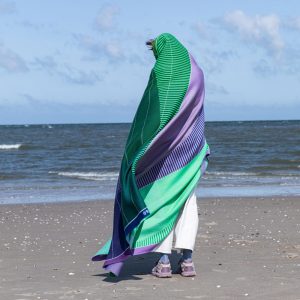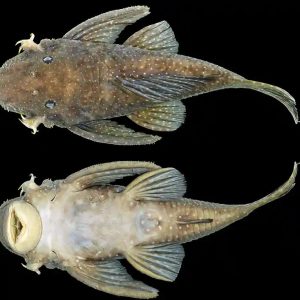Link About It: This Week’s Picks
Textiles embedded with data, new fish species, fashion in the metaverse and more

NASA’s Hubble Space Telescope Observes The Farthest Star Ever Seen
 Documented in a new study led by Johns Hopkins University PhD candidate Brain Welch and published in the scientific journal Nature, NASA’s Hubble Space Telescope has captured an image of a star estimated to be 28 billion light-years away—making it the most distant one ever seen. Named Earendel, this 12.9-billion-year-old cosmic object happens to be millions of times brighter than our solar system’s Sun, and is likely to be 50 to 500 times the size. Hubble was able to image the star thanks to a “cosmic coincidence” known as gravitational lensing wherein nearby galaxies “bend space into this natural telescope,” according to astronomer Michelle Thaller of NASA’s Goddard Space Flight Center. Read more about the phenomenon and the star at Astronomy.
Documented in a new study led by Johns Hopkins University PhD candidate Brain Welch and published in the scientific journal Nature, NASA’s Hubble Space Telescope has captured an image of a star estimated to be 28 billion light-years away—making it the most distant one ever seen. Named Earendel, this 12.9-billion-year-old cosmic object happens to be millions of times brighter than our solar system’s Sun, and is likely to be 50 to 500 times the size. Hubble was able to image the star thanks to a “cosmic coincidence” known as gravitational lensing wherein nearby galaxies “bend space into this natural telescope,” according to astronomer Michelle Thaller of NASA’s Goddard Space Flight Center. Read more about the phenomenon and the star at Astronomy.
Image courtesy of NASA, ESA, Brian Welch (JHU), Dan Coe (STScI), image processing by NASA, ESA, Alyssa Pagan (STScI)
Business of Fashion’s Notes From Metaverse Fashion Week
 From 23 to 27 March, Decentraland—the popular blockchain-based, 3D virtual world—hosted the world’s first Metaverse Fashion Week, a showcase expanding the boundaries of fashion in the metaverse. It’s still nascent but we expect continued evolution and development in the space and are monitoring it closely. “The biggest drawback is that the visuals are fairly basic, in part as a compromise to allow the experience to work smoothly on the internet’s present-day infrastructure,” writes Marc Bain, making it difficult to capture details on clothes and present more complex garments. Coupled with the lack of interactive components for the audience, basic visuals made virtual runways less effective. Aspects that did shine were digital wearables (some of which sold out) and the convergence of 2D imagery in 3D worlds, which was evidenced in Auroboros’ immersive space created with Grimes. Overall, this new frontier presented challenges as well opportunities. Check out Business of Fashion for the full review.
From 23 to 27 March, Decentraland—the popular blockchain-based, 3D virtual world—hosted the world’s first Metaverse Fashion Week, a showcase expanding the boundaries of fashion in the metaverse. It’s still nascent but we expect continued evolution and development in the space and are monitoring it closely. “The biggest drawback is that the visuals are fairly basic, in part as a compromise to allow the experience to work smoothly on the internet’s present-day infrastructure,” writes Marc Bain, making it difficult to capture details on clothes and present more complex garments. Coupled with the lack of interactive components for the audience, basic visuals made virtual runways less effective. Aspects that did shine were digital wearables (some of which sold out) and the convergence of 2D imagery in 3D worlds, which was evidenced in Auroboros’ immersive space created with Grimes. Overall, this new frontier presented challenges as well opportunities. Check out Business of Fashion for the full review.
Image courtesy of Marc Bain
Gender Marker “X” Available on US Passports
 On 11 April, US citizens will be able to select the gender marker X on passports, the State Department announced today. Additionally, the Department of Homeland Security has announced that the X designation will be included in the TSA Pre-Check program and TSA checkpoints will have gender-neutral scanners at airports. The move comes several months after the country’s first-ever passport with the X gender designation was issued, a move that aims to respect, reflect and celebrate the reality of many individuals in the US. Read more at The Daily Beast.
On 11 April, US citizens will be able to select the gender marker X on passports, the State Department announced today. Additionally, the Department of Homeland Security has announced that the X designation will be included in the TSA Pre-Check program and TSA checkpoints will have gender-neutral scanners at airports. The move comes several months after the country’s first-ever passport with the X gender designation was issued, a move that aims to respect, reflect and celebrate the reality of many individuals in the US. Read more at The Daily Beast.
Image courtesy of Vinta Supply Co/Pexels
Raw Color’s “Temperature Textiles” Collection is Embedded With Climate Data
 Created by Daniera ter Haar and Christoph Brach of the Eindhoven-based studio Raw Color, the Temperature Textiles collection of blankets, scarves and socks has climate change data knitted within. These colorful products incorporate information on the three main elements of global warming: temperature change, sea level rise and emissions. For example, the Sea Level Blanket illustrates the reported and predicted sea-level rise from 2000 to 2100, using data from the Intergovernmental Panel on Climate Change. Brach tells Rima Sabina Aouf at Dezeen that using textiles to manifest this information was crucial. “Textile was important for us because it manifests the data permanently. On a screen, one sees it temporarily,” he says. “Also, it is an object we can interact with. A blanket can keep us warm and it can actively help to turn down the heating.” Find out more at Dezeen.
Created by Daniera ter Haar and Christoph Brach of the Eindhoven-based studio Raw Color, the Temperature Textiles collection of blankets, scarves and socks has climate change data knitted within. These colorful products incorporate information on the three main elements of global warming: temperature change, sea level rise and emissions. For example, the Sea Level Blanket illustrates the reported and predicted sea-level rise from 2000 to 2100, using data from the Intergovernmental Panel on Climate Change. Brach tells Rima Sabina Aouf at Dezeen that using textiles to manifest this information was crucial. “Textile was important for us because it manifests the data permanently. On a screen, one sees it temporarily,” he says. “Also, it is an object we can interact with. A blanket can keep us warm and it can actively help to turn down the heating.” Find out more at Dezeen.
Image courtesy of Raw Color
Wolverine Fish, Blind Eel and 210 More New Fish Species Found
 Conservation organization Shoal announced that scientists have discovered 212 new freshwater fish species in the last year—a remarkable feat not only for the unprecedented number, but also for all the extraordinary creatures it represents. The New Species 2021 report includes the Hopliancistrus wolverine (aka the Wolverine fish), which surprised researchers with a hidden weapon system tucked underneath its gill covers. Other species—like the Mumbai blind eel (which has no fins or scales) and the male Danionella cerebrum (which can make drumming sounds)—were unusual finds. “It’s fascinating that over 200 new freshwater fish species can be described in just a single year,” says Shoal’s conservation program manager Harmony Patricio. “It means there are still hundreds and hundreds more freshwater fish out there in the world that scientists don’t know about yet.” With more than one third of freshwater species currently threatened with extinction, this discovery comes at a critical time to bring awareness. Learn more at The Guardian.
Conservation organization Shoal announced that scientists have discovered 212 new freshwater fish species in the last year—a remarkable feat not only for the unprecedented number, but also for all the extraordinary creatures it represents. The New Species 2021 report includes the Hopliancistrus wolverine (aka the Wolverine fish), which surprised researchers with a hidden weapon system tucked underneath its gill covers. Other species—like the Mumbai blind eel (which has no fins or scales) and the male Danionella cerebrum (which can make drumming sounds)—were unusual finds. “It’s fascinating that over 200 new freshwater fish species can be described in just a single year,” says Shoal’s conservation program manager Harmony Patricio. “It means there are still hundreds and hundreds more freshwater fish out there in the world that scientists don’t know about yet.” With more than one third of freshwater species currently threatened with extinction, this discovery comes at a critical time to bring awareness. Learn more at The Guardian.
Image by Juan Marcos Mirande, Fundacion Miguel Lillo; courtesy of PLoS One
INVERSE’s “ASAP Awards” Recommends Now-Streaming Sci-Fi Movies
 Science-centric website INVERSE released their 2022 ASAP Awards: a list celebrating science fiction films that are currently streaming. Essentially a guide to innovative, interesting and iconic movies, the titles include Bong Joon-ho’s brilliant 2013 film Snowpiercer (aka “You need to watch the most important sci-fi thriller of the century ASAP”), the 1973 French and Czech animated co-production Fantastic Planet (aka “You need to watch the most surreal sci-fi movie on HBO Max ASAP”), Rian Johnson’s 2013 trip Looper (aka “You need to watch the most mind-blowing time travel thriller on Netflix ASAP”) and more. Take a look at the thoughtfully selected list at INVERSE.
Science-centric website INVERSE released their 2022 ASAP Awards: a list celebrating science fiction films that are currently streaming. Essentially a guide to innovative, interesting and iconic movies, the titles include Bong Joon-ho’s brilliant 2013 film Snowpiercer (aka “You need to watch the most important sci-fi thriller of the century ASAP”), the 1973 French and Czech animated co-production Fantastic Planet (aka “You need to watch the most surreal sci-fi movie on HBO Max ASAP”), Rian Johnson’s 2013 trip Looper (aka “You need to watch the most mind-blowing time travel thriller on Netflix ASAP”) and more. Take a look at the thoughtfully selected list at INVERSE.
Image courtesy of Moho Film/Opus Pictures
Concrete Made From Old Tires Proves Tougher and More Sustainable
 One of the world’s most widely used materials, concrete is responsible for 8% of global carbon emissions. To find more sustainable alternatives, researchers often look to other resources and, in this case, have turned to old rubber tires. A new study from scientists at the University of South Australia and Melbourne’s RMIT University used crumb rubber concrete—concrete made by grinding used tires into crumb-like pieces—as a residential slab to test its viability. The scientists poured two slabs of it, along with additional conventional concrete, to construct the entrance to the Civil Engineering campus 2018. They monitored and compared the material’s performance, finding that the crumb rubber had higher impact-resistance, toughness, ductility, damping ratio and better thermal and acoustic insulation. “The results clearly show that crumb rubber cement is a viable and promising alternative to conventional concrete,” says author of the study Professor Yan Zhuge. Learn more about it at New Atlas.
One of the world’s most widely used materials, concrete is responsible for 8% of global carbon emissions. To find more sustainable alternatives, researchers often look to other resources and, in this case, have turned to old rubber tires. A new study from scientists at the University of South Australia and Melbourne’s RMIT University used crumb rubber concrete—concrete made by grinding used tires into crumb-like pieces—as a residential slab to test its viability. The scientists poured two slabs of it, along with additional conventional concrete, to construct the entrance to the Civil Engineering campus 2018. They monitored and compared the material’s performance, finding that the crumb rubber had higher impact-resistance, toughness, ductility, damping ratio and better thermal and acoustic insulation. “The results clearly show that crumb rubber cement is a viable and promising alternative to conventional concrete,” says author of the study Professor Yan Zhuge. Learn more about it at New Atlas.
Images courtesy of Depositphotos
Link About It is our filtered look at the web, shared daily in Link and on social media, and rounded up every Saturday morning. Hero image courtesy of Raw Color












